Welcome to We Are Your Yemeni Students! This page intends to introduce educators to the rich history and breadth of experiences that students from Yemeni families bring to American classrooms. We hope that reading this page will contribute to a more holistic understanding of Yemen, its people, and members of the diaspora.

Table of Contents
Page Navigation: Click the links to go to the different sections on the page.
History
Pre-Modern History
Yemen’s location on the Southwestern tip of the Arabian Peninsula, at the crossroads of the Red Sea and the Arabian Sea made it a central location in both the Indian Ocean and Mediterranean trade networks. Under the rule of successive Southern Arabian Kingdoms, the territory of contemporary Yemen was known as Arabia Felix (“Happy Arabia” in Latin) because it enjoyed significant prosperity as an overland link for the trade of luxury goods between Egypt, Mesopotamia, and the Mediterranean. In addition to its close contact with the Arab world through commerce linked to the spice trade, Yemen has a long relationship with East Africa, particularly the region that is today Ethiopia, Eritrea, Djibouti, and Somalia.
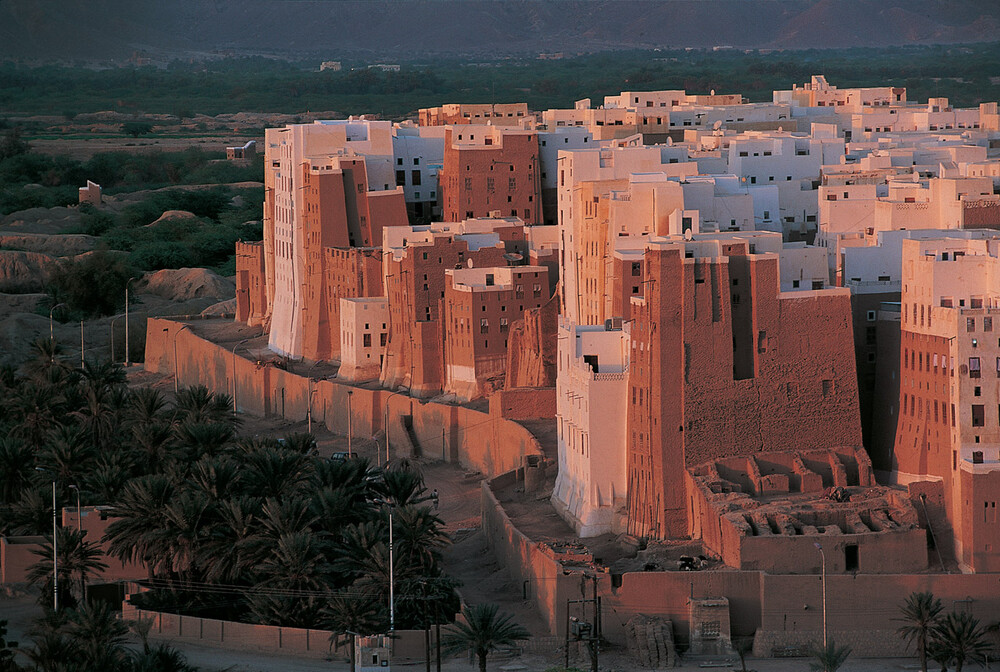
Islam was adopted in Yemen beginning around 630 CE and Yemen was incorporated into Arab caliphates over subsequent centuries. Northern Yemen came under the influence of Zaidi (Zaydi) Shi’a leaders. The influence of both Islam and Yemen’s pre-Islamic past can be seen in surviving architecture. Some of the most notable features of Yemeni architecture include “tower-houses” made of mud and / or stone which look out onto communal streets. Surviving structures in Shibam (built in the 16th century) and the old city of Sana’a are as tall as nine stories high and serve as some of the oldest examples of vertical construction in urban planning.
To learn more, visit https://yemenembassy.it/sanaa/ and https://whc.unesco.org/en/list/192/.
North / South Trajectories
Northern and Southern Yemen experienced different histories prior to their unification as the Republic of Yemen in 1990.
From the fourteenth to nineteenth centuries Northern Yemen was politically controlled by the Ottoman Empire in urban areas and by the Zaidi religious leadership in rural areas. In the early 1900s, Northern Yemen was recognized as an autonomous territory by the Ottomans under the leadership of Imam Yahya ibn Muhammad of the Zaidi sect. After Yahya was assassinated in a 1948 coup, he was succeeded by his son Imam Ahmad. During Imam Ahmad’s reign, friction with the British-controlled South increased as pressure to comply with nationalist anti-colonial sentiment rose in North Africa and the Arab world. Under the rule of the imams, Northern Yemen pursued isolationist policies and became increasingly theocratic.
Unlike the North, Southern Yemen was influenced by the British, who captured the port city of Aden in 1839 and ruled the region as a protectorate of British India until 1937. By 1965, most of the tribal states that composed the Southern Yemen formed the Federation of South Arabia with the backing of the British. While different groups fought for control of the Federation, the final remaining British troops withdrew in November of 1967. In 1970, Southern Yemen was renamed the People’s Democratic Republic of Yemen, and the state grew closer with the USSR, pursuing anti-colonial policies such as the nationalization of foreign-owned property.
See this historical analysis from New Mexico State University and this brief history of Yemen for additional information.
Civil War & Humanitarian Crisis (2014-Present)
Key Facts
More than 2/3 of Yemen’s population (32.98 million total) has been affected by the civil war, with 4 million Yemenis forced to flee their homes.
79% of those displaced are women and children.
20.7 million people in Yemen are in dire need of humanitarian assistance.
16.2 million Yemenis suffer from hunger, including 5 million on the brink of famine. 3/4 of the population are dependent on aid to survive.
See https://www.unrefugees.org/emergencies/yemen/ for more information.
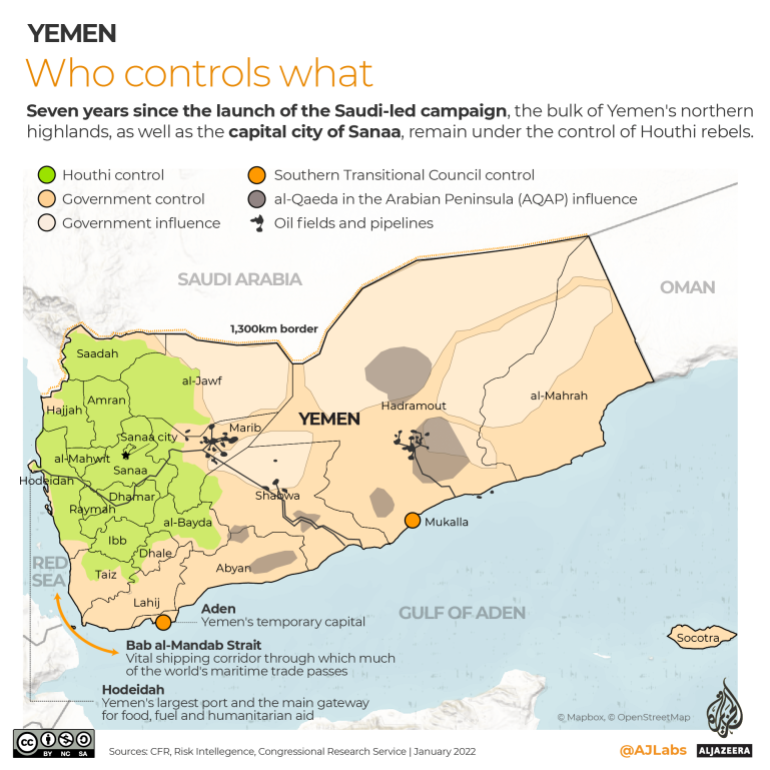
Learning about Yemen’s contemporary history is crucial for a better understanding of your Yemeni students’ experience of displacement, allowing you to nurture their learning in a sensitive and thoughtful way.
Yemen is currently undergoing a brutal civil war, which has disrupted the country’s economy, political system and society at large, leading to the displacement of more than 4 million Yemeni individuals around the world and driving Yemen into what the United Nations now calls the “world’s worst humanitarian crisis“.
The conflict pits two different sets of actors: the internationally recognised Sunni government backed by Saudi Arabia, and the Houthi insurgents, Shiite rebels backed by Iran who had conducted armed rebellions against the Sunni government since 2004. The war erupted in September 2014, when Houthi rebels overthrew the Sunni government, taking control of Yemen’s capital and largest city, Sana’a, asking for lower fuel prices and a new government.
But different actors have come to complicate the picture of the conflict. Indeed, the conflict can be seen as an extension of the Iran-Saudi Arabia proxy conflict over the Middle East. Both regions are competing for regional hegemony, a political and economic competition exacerbated by religious differences. Each country ascribes to one of the two main branches of Islamic faith: Iran is largely Shia Muslim, and Saudi Arabia is largely Sunni Muslim. The whole Middle Eastern region has become their battlefield.
In Yemen, Houthis’ takeover of the country has been viewed as a threat by Saudi Arabia, as the rebels are backed by their decade-old rival, Iran. Sharing a 812 miles-long border with Yemen, the Sunni regional power fears greater Iranian influence seeping into its country. As a result, in March 2015, Saudi Arabia led a coalition of Gulf states in its Operation Decisive Storm, a campaign of economic isolation and military operations using airstrikes to drive the Houthis out and to restore the former Yemeni government.
Other actors have taken advantage of this environment of state collapse, political instability, war economy and power vacuums: Al-Qaeda in the Arabian Peninsula (AQAP) and the Islamic State of Iraq and Syria (ISIS) have carried out attacks and have taken control of swathes of territory in the hinterlands and along stretches of the coast.
The US has lent its support to the coalition, providing intelligence and logistical support for the campaign as part of its counterterrorism strategies in the Middle East. The US has notably equipped the Royal Saudi Air Force (RSAF) with American aircraft. Local observers in the Yemen Data projects have accounted for more than 25,000 air raids conducted by the Saudi-led coalition since the start of the war, injuring more than 10,000 and killing approximately 9,000 Yemeni civilians.
The Yemen civil war has since morphed into an intractable conflict and is at a stalemate, violence intensifying since 2021, with shifting alliances and economic collapse. The Covid-19 pandemic has worsened the impacts of the humanitarian crisis, vaccine campaign efforts considerably hampered by the ongoing fighting.
The impacts on the country’s population have been dire. In 2021, the United Nations Office for the Coordination of Humanitarian Affairs (OCHA) estimated that the Yemen civil war caused the deaths of a quarter of a million people. More than half of the population is facing extreme food insecurity, the national currency’s collapse leading to skyrocketing food prices, reducing citizens’ purchasing power and preventing their ability to meet their basic needs.
Want to know more about the broader conflict between Saudi Arabia and Iran, which affects the conflict in yemen? Watch the video below.
For a recent update on the Yemen Civil War, a comprehensive overview of the conflict, and footage of present-day Yemen, watch the video below.
Takeaways for Teachers
Highlighting Intrastate Diversity
While creating lesson plans that showcase Yemen or other countries in the Arab world, it is important to keep in mind the breadth of influences on Yemen’s historical development. Yemeni historical and cultural experiences are highly varied, and the Yemeni people are not a monolith. For instance, multiple dialects of Arabic are spoken within the country, the experience of urban residents are distinct from those who live in rural areas, and although Islam has greatly influenced Yemeni development, not all Yemenis are Muslim.
Going Beyond the Conflict
Understanding the history of Yemen’s civil war and the humanitarian challenges in the country is necessary for contextualizing the experiences of Yemeni students. However, Yemen’s history of violence should not be the sole focus. Yemen has made invaluable contributions to fields such as philosophy, religion, art, architecture, and science. These aspects of Yemen’s history should be highlighted and celebrated in the classroom.
Education System
Yemen’s Education System at a Glance
- Primary education is compulsory for children aged 6-14.
- Secondary education is optional for children between the ages of 15-17.
- The standard language of instruction is Modern Standard Arabic.
- Schools are commonly religious-based, but private, secular schools exist in urban settings.
Education in Yemen
Education has always been important in Yemeni culture, with the government spending approximately 1/5th of their budget on education each year. While Yemen offers free and compulsory basic education, only 46% of eligible students enroll in school. According to the Borgen Project, approximately 2 million Yemeni children miss school each day. This is a striking decline from Yemen’s 97.5% student enrollment rate just years before the conflict.
Current Conflicts Affecting School-Age Children
- Children in Yemen face dangers both in and out of school. Outside of school, children face the danger of recruitment into the conflict. According to the UN, approximately 1200 children as young as eight have been enlisted to fight. While the classroom can serve as a buffer between students and the conflict, many schools have become sites of violence as well.
- More than 3600 schools have closed in Yemen since the conflict began. School bombings, shootings, and other acts of violence have driven millions of children from the classroom and have left

Arts & Literature
Spotlight on Street Art
Some Yemeni artists have responded to the humanitarian crisis and highlighted community voices through street art. Murals created by two street artists, Haifa Subay and Murad Subay, are shown below. In addition to creating works of his own, Murad Subay organizes an annual “Open Day of Art” where residents of Taiz, Sana’a, Ma’arib, and other cities can participate in the process of creating murals.
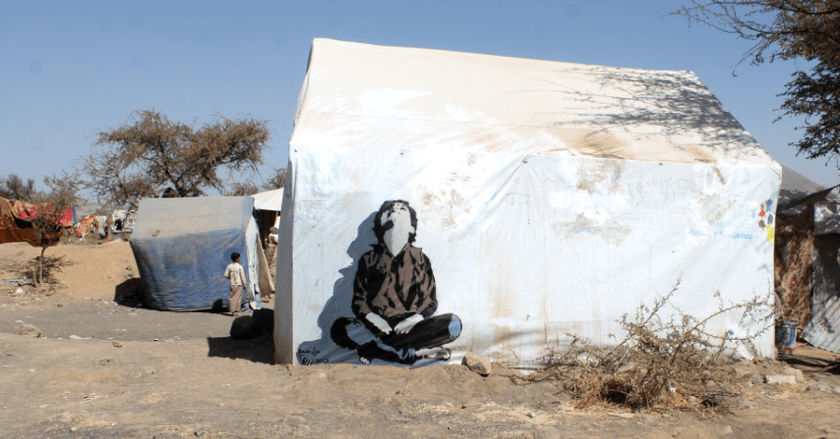
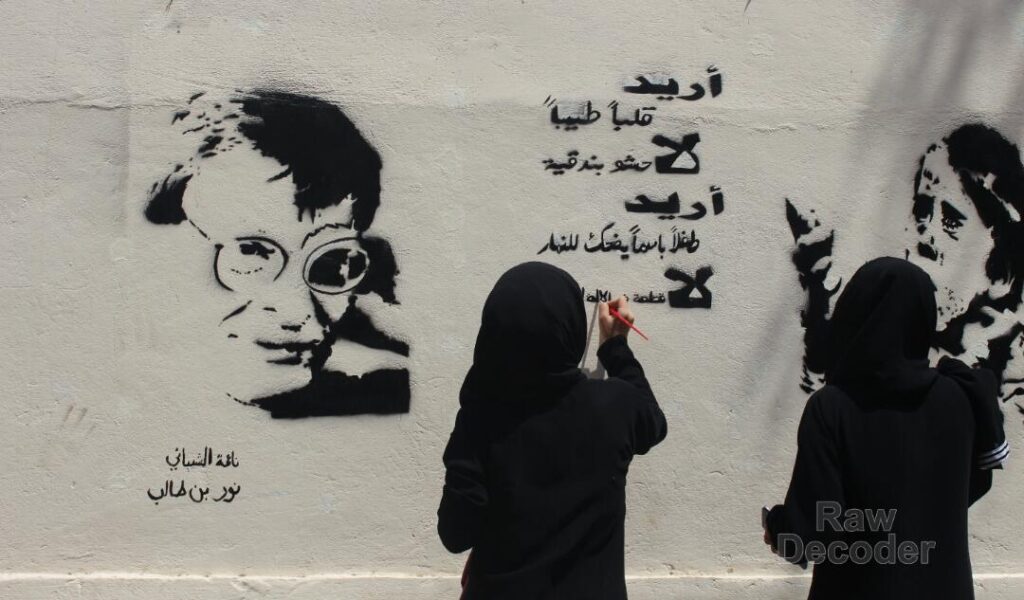
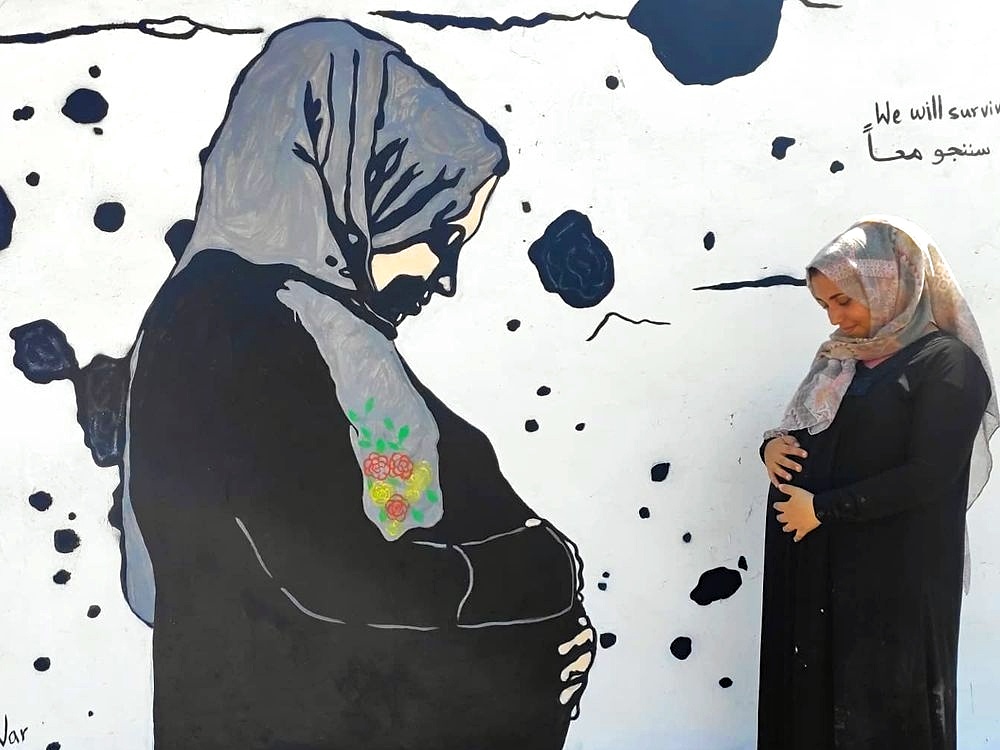
To learn more about the visual and creative arts in Yemeni, and the role of Yemeni youth in creating dialogue through artwork, see the following articles from USAID and the Middle East Eye:
Tim Cornwell, “Invisible but Alive: How the Art Scene is Surviving in Yemen,” Middle East Eye, July 17, 2019.
Literature
Regretfully, much of the English language literature pertaining to Yemen is not written by Yemeni authors. The following resources reflect our efforts to include Yemeni authors where possible, however we encourage you to conduct your own research, as well, in order to seek out and center Yemeni voices.
Children’s Literature
Under the Sana’a Skyline, Salwa Mawari. Tell Me More about Ramadan, Bachar Karroum (Not specific to Yemen).
Non-Fiction
All American Yemeni Girls: Being Muslim in a Public School, Loukia Sarroub. Yemen: Dancing on the Heads of Snakes, Victoria Clark.
Yemen Endures, Ginny Hill.
Fiction
The Monk of Mokkha, Dave Eggers. Hurma, Ali al-Muqri. My Destiny is a Butterfly, Safa’a Al-Habal. Soslof’s Daughter, Habib Sorori. The Revolutionist, Mohammed Algharbi Amran.

To learn more about Yemen’s recent literary revival, and many of the young people who are driving it, see this article from Al Jazeera (https://www.aljazeera.com/features/2020/3/28/young-gifted-and-yemeni-writers-find-inspiration-despite-war) and this feature from arablit.org (https://arablit.org/2015/03/27/6-authors-who-are-part-of-yemens-literary-history-and-literary-resurgence/).
Culture
Religion
- The Shafi’i school of Sunni Islam is widely practiced in the South and West while the Zaydi school of Shia Islam is the largest religious denomination in the North and East of Yemen.
- In total, around 60% of Yemen’s population is Shafi’i Sunni.
- The Constitution of Yemen provides for freedom of religion, and the Government generally respects this right in practice.
- Yemen is also home to a small Christian community and an even smaller Jewish community.
- The Constitution declares that Islam is the state religion, and that Shari’a (Islamic law) is the source of legislation. Muslims and followers of religious groups other than Islam are free to worship according to their beliefs, but the Government prohibits conversion from Islam and the proselytization of Muslims.
Holidays
Eid al-Fitr: This holiday marks the end of the Ramadan, the month-long dawn to sunset fasting, on the first day of the 10th month of the Islamic calendar.
Eid al-Adha: On the 10th day of the last month of the Islamic calendar, this is the Holiday of Sacrifice.
- These major religious holidays in Yemen are celebrated with prayer, religious talks, visits to family, and important communal meals. These holidays fall on different dates of the Gregorian calendar used in the United States.
- To integrate the culture of your Yemeni students in class, a nice gesture would be to look up the dates of both these holidays using this calendar and to greet your students by saying “Eid Mubarak.”
Read the following article to learn how some members of the Yemeni community in New York celebrate Eid!
Karen Zraick, “Celebrating Eid, and Yemen, in New York.”
Language
- Arabic is the predominant language spoken throughout Yemen (about 90%).
- Modern Standard Arabic is taught in schools, but various dialects are spoken throughout different regions of the country, that are derived from Arabic.
Here is one of many online tutorials that introduces viewers to basic Arabic words and phrases that you can use with your students.
“20 Arabic Words for Everyday Life,” https://www.youtube.com/watch?v=AR6oclY-3jY
Cuisine
- Traditional Yemeni cuisine is broadly similar to that found in other areas of the Arabian Peninsula, but it is also heavily influenced by the cuisine of eastern Africa and South Asia.
- The major meats are chicken and goat. Other staples include potatoes, lentils, peas, onions, and tomatoes. There are several types of bread and unleavened flat bread is typical.
- A popular dish in Yemen is saltah, a stew of lamb or chicken that is heavily spiced with fenugreek and other herbs.
- Tea is a common drink, and coffee is very popular.
- Alcoholic beverages are considered culturally and religiously inappropriate.

Check out the following resources for information about Yemeni restaurants, coffee shops, and businesses in New York City!
Nicholas Niarchos, “Yemen in Brooklyn.”
Saki Knafo, “Yemenis in Brooklyn Reclaim High-End Coffee.”
See how students from P.S. 216 learn about Yemen’s culture through recipes and culinary lessons.
Family & Etiquette
- Important Yemeni cultural values include hospitality, generosity, respect for elders, decency, and good manners while eating from a communal dish.
- Extended family is an important part of Yemeni cultural heritage. It is customary that young men continue to live with their parents and grandparents after marriage.
- Yemeni children often will live with their parents and paternal grandparents in Yemen.
Takeaways for Teachers: Owing to the importance of family in Yemeni life, it is be important to include the extended, rather than just the nuclear family, in lesson plans and classroom discussions. As an educator, you may also be in close contact with the grandparents, not just the parents of your Yemeni students.
Yemeni Community in New York City
Little Yemen(s)
The Bronx
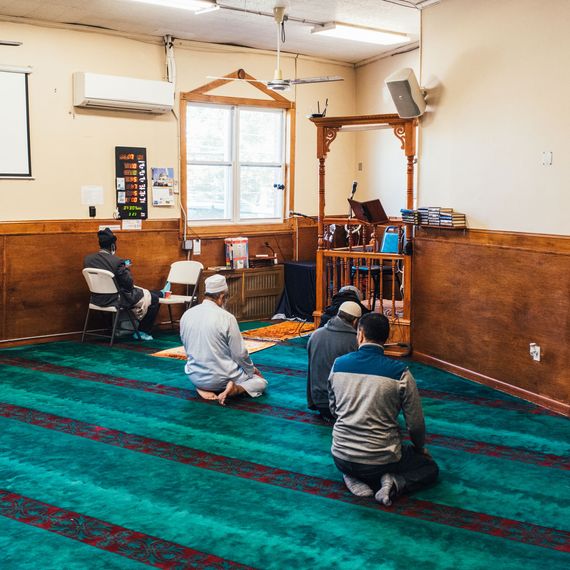
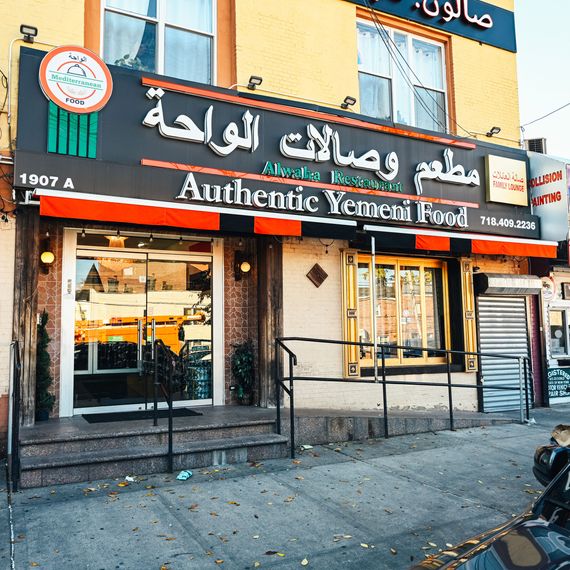
One of two enclaves that are most widely referred to as ‘Little Yemen’ is located in Morris Park, in the Eastern part of the Bronx. The neighborhood is home to a halal meat market, community mosques, and popular Yemeni restaurants, like Arth Aljanatain. Arabic-language services are also available to help residents with taxes, translation, immigration processes, etc. Since June 2019, the community has hosted an annual Yemeni American Day Parade.
See this 2019 article from the Bronx Ink and this feature in Grub Street for more information about the neighborhood, its residents, and community events.
BROOKLYN
Brooklyn’s Little Yemen community is located in Bay Ridge, in the southwest of the borough, where an immigrant community has grown since the 1980s. The Yemeni-American community in Brooklyn boasts a vibrant cultural and commercial scene with many coffee shops, restaurants, and other Yemeni-owned businesses. One of the most notable neighborhood establishments is the Yemen Café, opened in 1986.
Check out this video for a virtual walking tour of Brooklyn’s Little Yemen!

For voices from Little Yemen in Brooklyn see the following podcast, which includes a discussion on “Yemeni-Americans and the Pursuit of Education.” The transcript for this podcast episode can be found here.
Current Events Affecting the New York Yemeni Community
Like those in other communities of Arab descent or Muslim faith who live in the United States, members of the Yemeni diaspora experience Islamophobia and are impacted by exclusionary immigration policies.
Read this article from Vice to learn more about the activism and protests organized by members of New York’s Yemeni community in response to an Executive Order from President Donald Trump which, in 2017, barred all refugee admissions from several Muslim-majority countries, including Yemen.
Schools are an important place where students receive messaging about their role as civic actors and right to belong in American society. In order to support and fully include your Yemeni students in the classroom, it is necessary to actively dispel alienating myths and stereotypes. Please refer to the Teaching Beyond September 11th Curriculum (https://www.gse.upenn.edu/academics/research/september-11-curriculum) and the following guide from the University of Pennsylvania (https://www.gse.upenn.edu/news/educators-playbook/teaching-beyond-911) for a discussion of how you can resist discrimination and push back against harmful narratives while building solidarity with your Arab, Muslim, and South Asian students.
To stay up to date on current events affecting the Yemeni-American community see this Yemeni American news hub with relevant English language articles.
Takeaways for Teachers
Refugee families and children face a variety of challenges that you should take into consideration as their teacher. While you will not be able to resolve all potential challenges your refugee student faces, you can provide compassion and consideration for their circumstances.
While your Yemeni refugee student’s experiences are undoubtedly unique, they may relate more broadly to the experience of refugee and immigrant children in America. While it’s important to understand the specific circumstances regarding Yemen, you can also help your student by understanding their experience as a refugee in the United States.
The following sample questions can be used to begin a dialogue and respond to your students’ individual needs:
- Academic Considerations
- Does your student speak English? If so, what’s their fluency level?
- How can you support a student’s learning if there’s a language barrier? Can your school provide an Arabic translator, or can you use apps to assist you?
- Has your student experienced disruption in their education? If so, how much?
- How does your student’s previous education relate to and differ from American education standards?
- Is your student familiar with your school’s basic requirements and expectations? Do they understand what subjects are taught and the typical schedules for the day or the week?
- Does your student need extra help with development in math and reading?
- How does the American grading system relate to and differ from the Yemeni grading system? Does your student understand American grading?
- How does the American testing system relate to and differ from the Yemeni testing system? Does your student understand American testing?
2. Socialization Considerations
- How does your school culture relate to and differ from Yemeni school culture
- How can you integrate bits of Yemeni culture into your classroom? Can your class learn about Yemen through a book, or learn about the Muslim religion, for example?
- How might your student’s refugee status affect their ability to concentrate for extended periods of time? Can you offer more breaks or restful activities?
- How might your student’s refugee status affect their ability to work in groups successfully? Can you offer different types of group work?
- How might your student’s refugee status affect their ability to attend school consistently? Is there a way to know when they might miss school, so you can give them lesson materials in advance?
- How do American teacher-student relationships relate to and differ from Yemeni teacher-student relationships?
- How do American school discipline policies relate to and differ from Yemeni school discipline policies? How might you transition your student to better understand American school discipline policies? How might you meet their understanding?
- Resource Needs Considerations
- Does your student have adequate clothing and school supplies when they come to class? If not, how can your school or local organizations assist your student?
- Does your student have stable and adequate housing? Is your student safe at home? If not, how can your school or local organizations assist your student?
- Has your student received support from multiple adults in your school? How can you increase the circle of care for your student?
- Has your student connected with your local community? How can you engage your student in the community?
- Is your student making friends? What can you do to encourage new friendships?
- Has your student faced anti-immigration or Islamophobic attacks inside or outside of school? How can you foster an inclusive environment in your classroom? What organizations can assist your student with this outside of the classroom?
- Mental and Physical Health Considerations
- Could your student benefit from counseling services? How can you or your school assist your student in obtaining such support?
- Could your student have experienced violence? If so, how might you adjust your teaching to accommodate your student?
- Does your student appear to have personal hygiene products?
- Does your student appear to receive hearing, dental, and vision screenings? Does your school or any free organization offer these services?
- Does your student have access to medical care and vaccinations? How might you offer information about those services?
10 Additional Tips to Support Your Yemeni Students
- Learn about your students and their families. Communicate directly or through a translator with both the student and their family frequently.
- Familiarize yourself with refugee and Yemeni resources in your community.
- Create space for your students to share their experiences either with yourself or a school counselor.
- Integrate students’ cultures into lessons and classroom activities.
- Increase exposure to the English language through low-stake materials, such as games, books, and music.
- Advocate for your student to utilize as many school resources as they need.
- Offer to help find resources for your student and their family.
- Remember that your students may be struggling with physical or mental health illnesses. Trauma can affect a child’s education performance in a variety of ways.
- To help you in sensitive classroom situations, please consult The National Child Traumatic Stress Network’s website, https://www.nctsn.org/ , which has useful toolkits for educators dealing with traumatized children.
- Widen the circle of support by recruiting trusted teachers and school administrators to frequently check in on your student. This will take some pressure and potential guilt off of you, and it will benefit your student!
- Allow yourself and your student to make mistakes. Every situation is unique, and no one is perfect!
Leave a Reply